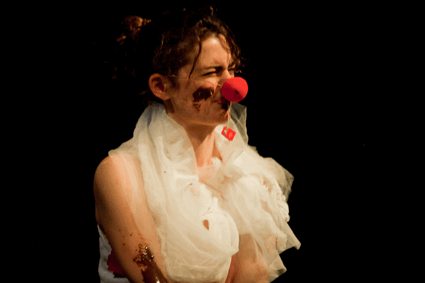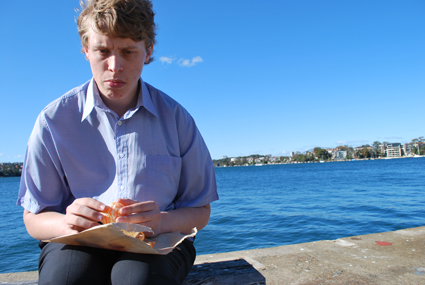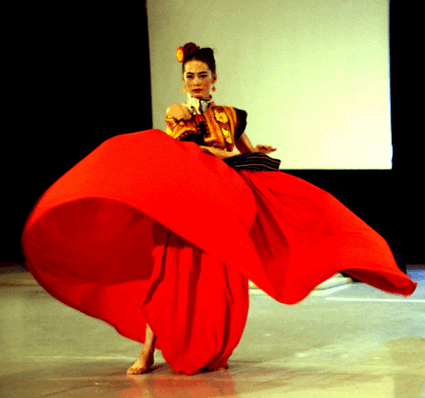expanding on the solo
caroline wake: sydney fringe festival, pact

Alice Mary Cooper, Clown Lights Stage
photo Yann Audic
Alice Mary Cooper, Clown Lights Stage
LAST YEAR’S SYDNEY FRINGE FESTIVAL BOASTED SOME 200 SHOWS, PERFORMED IN THREE SUBURBS OVER TWO WEEKS, LEADING KEITH GALLASCH TO MUSE THAT IT “MAY WELL HAVE GAINED SUFFICIENT TRACTION TO GUARANTEE ITSELF A FUTURE” (SEE RT100 http://www.realtimearts.net/article/100/10122). AND INDEED IT HAS. THIS YEAR THE FESTIVAL GAINED ANOTHER 50 SHOWS, THREE SUBURBS AND AN ADDITIONAL WEEK.
With so many performances to choose from, I decided to navigate the festival via a venue—the PACT Centre for Emerging Artists in Erskineville—where I attended eight shows. Unfortunately I can’t cover them all here, so I’m focusing on the five solo works which dominated the program.
clown lights stage
Alice Mary Cooper arrives on the blackened stage wearing a white singlet and underpants and carrying a red handbag. “The good news,” she announces, “is that Alice is going to be okay; the other good news is that I am here to help.” Thus, with an air of slightly forced cheer, the clown starts to rifle through the contents of the absent Alice’s bag and then to perform her show. It’s hungry work, of course, and so she opens a jar of hazelnut spread only to misunderstand the instructions and smear the brown stuff all over her body. These markings remain as she discusses all things French, from Romanticism to French Onion dip, before delivering a rousing rendition of “Non, Je ne regrette rien” but with lyrics to include “baguette” and “croissant.” Elsewhere, she eats a teabag, has some misadventures with a tampon, and enacts most of the Greek tragedies. Balanced between the banal and the surreal, and performed with a very deft touch, Clown Lights Stage is truly delightful.

Nathan Harrison, The art and craft of approaching your head of department to submit a request for a raise
photo Rachel Roberts
Nathan Harrison, The art and craft of approaching your head of department to submit a request for a raise
the art and craft of approaching your head of department to submit a request for a raise
While you couldn’t call it clown, Nathan Harrison’s show also features a naïve protagonist negotiating an absurd world. Based on Georges Perec’s slim volume, which was published in French in 1969 and in English this year (!), The Art and Craft leads us through a series of increasingly unlikely scenarios as the protagonist advises on how to go about asking for that raise. Ten minutes into the performance and we have only just knocked on the boss’s door; it takes the remaining 40 minutes to canvass what sort of lunch to eat beforehand, how and when to sit down, what sort of small talk to make, when to fake comprehension and when to admit ignorance etc. The language is looping, repetitive and frustrating but there is clarity of purpose to both the writing and the performance. Together they come to resemble a flow chart in material form—an impossible attempt to account for every conceivable combination of events that could emerge and more besides. Harrison states that this is part of a larger project investigating performance structured by mathematical and scientific models, but it also reminded me of some of his work with Applespiel, specifically Executive Stress/Corporate Retreat (RT103). Like that performance, this one seems to speak to current workplace relations, where even government agencies spout corporate rhetoric, everyone is on rolling contracts and the unions negotiate deals where wages barely keep pace with inflation even as employers warn of an imminent skills shortage. For this reason alone, Harrison’s comic timing is impeccable.
gobbledygook
Bodysnatchers’ show lacks the conceptual clarity of Cooper and Harrison’s, but has some interesting moments nonetheless. Perhaps the most intriguing occurs when the protagonist (Aileen Huynh) has a phone conversation with her friend on the other end. When the conversation is over, it emerges that she has recorded it on her iPhone; she now replays the interaction but, this time, we hear the other part. This is where form and concept meet, but for the most part the phone serves merely as a prop and the performance risks becoming little more than an advertisement for its manufacturer. This lack of self-reflexivity, coupled with the redundant citation of philosopher Giorgio Agamben in the program notes, would seem to indicate that the artists haven’t fully resolved just what it is they want to say about phones, beyond the fact that they are part of the fabric of our lives.
dust
Thinking about the minerals that make our phones, and the possibility of reaching “peak minerals” in the same way that we have reached “peak oil,” provides an interesting background for Emeline Forster’s dance work. Taking its inspiration from the last man to leave a Queensland town before an open cut coal mine virtually swallowed it whole, Dust investigates the deadly pas de deux Australia now finds itself in with miners. Sections of slow rotating movement alternate with video footage of mines, towns and various products made with minerals. In the best sections, the two interact with Forster going behind the screens and playing with the combination of shadows and projections, so that she seems to stalk herself—an apt image indeed.

Meiwah Williams, Las Dos Fridas,
photos (standing) Roger Rossel, (seated) Ben Walsh
Meiwah Williams, Las Dos Fridas,
las dos fridas
Meiwah Williams’ Two Fridas is also full of compelling images (co-designed with Rachel Brown), starting with a white skirt suspended mid-stage, onto which is projected an image of a blue sky, white clouds and another white skirt. The effect is, appropriately enough, surreal. In another scene, Williams paints a piece of wax paper with water, slowly revealing one of Frida Kahlo’s self-portraits. The most magical moments are also the most acrobatic—Williams shimmying up the pink silks and tumbling down or when she executes a series of back flips in a full black skirt. While I initially wondered “why Frida, why now?,” the irresistible image of a dancing Kahlo wins me over.
3QUARED = 9 Fantastic Fabrications, Sydney Fringe@PACT; Clown Lights Stage, writer, designer, performer Alice Mary Cooper, dramaturg, mentor Michael Piggot, music Michael Meem; The Art and Craft of Approaching Your Head of Department to Submit a Request for a Raise, based on text by Georges Perec, devisor, performer Nathan Harrison, creative consultants Applespiel; Bodysnatchers, Goobledygook, director Mark Rogers, performer Ailenn Huynh, lighting Joseph Parro, sound design, composition Liam Halliwell, Jordan Thomson, dramaturg Sanja Simic; Dust, creator, performer Emiline Forster, video Emiline Forster, music Terry Hart, lighting Geoff Adams; Las Dos Fridas, performer, director Meiwah Williams, music Ben Walsh, visuals Rachel Brown and Meiwah Williams, vocals Maja Petrovna; PACT, Sydney, Sept 8-Oct 2
This article first appeared in the online e-dition Nov 8
RealTime issue #106 Dec-Jan 2011 pg. 33






